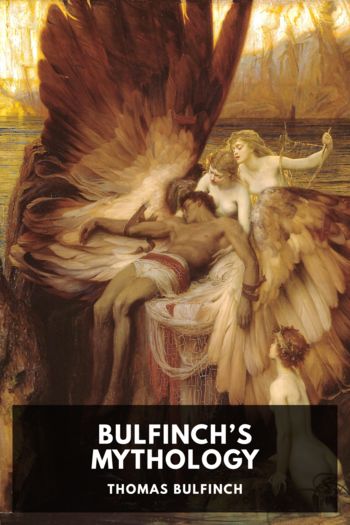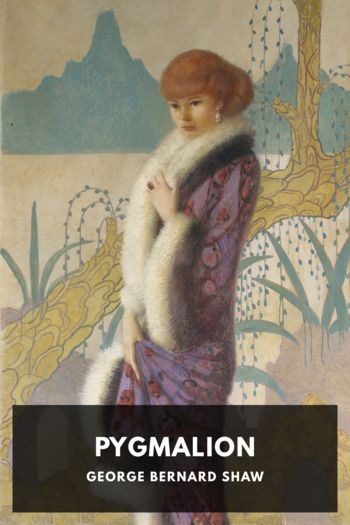Bulfinch’s Mythology, Thomas Bulfinch [love story books to read txt] 📗

- Author: Thomas Bulfinch
Book online «Bulfinch’s Mythology, Thomas Bulfinch [love story books to read txt] 📗». Author Thomas Bulfinch
In the garden of her temple, in her own island of Cyprus, is a tree with yellow leaves and yellow branches and golden fruit. Hence she gathered three golden apples, and, unseen by anyone else, gave them to Hippomenes, and told him how to use them. The signal is given; each starts from the goal and skims over the sand. So light their tread, you would almost have thought they might run over the river surface or over the waving grain without sinking. The cries of the spectators cheered Hippomenes—“Now, now, do your best! haste, haste! you gain on her! relax not! one more effort!” It was doubtful whether the youth or the maiden heard these cries with the greater pleasure. But his breath began to fail him, his throat was dry, the goal yet far off. At that moment he threw down one of the golden apples. The virgin was all amazement. She stopped to pick it up. Hippomenes shot ahead. Shouts burst forth from all sides. She redoubled her efforts, and soon overtook him. Again he threw an apple. She stopped again, but again came up with him. The goal was near; one chance only remained. “Now, goddess,” said he, “prosper your gift!” and threw the last apple off at one side. She looked at it, and hesitated; Venus impelled her to turn aside for it. She did so, and was vanquished. The youth carried off his prize.
But the lovers were so full of their own happiness that they forgot to pay due honor to Venus; and the goddess was provoked at their ingratitude. She caused them to give offence to Cybele. That powerful goddess was not to be insulted with impunity. She took from them their human form and turned them into animals of characters resembling their own: of the huntress-heroine, triumphing in the blood of her lovers, she made a lioness, and of her lord and master a lion, and yoked them to her car, where they are still to be seen in all representations, in statuary or painting, of the goddess Cybele.
Cybele is the Latin name of the goddess called by the Greeks Rhea and Ops. She was the wife of Cronos and mother of Zeus. In works of art she exhibits the matronly air which distinguishes Juno and Ceres. Sometimes she is veiled, and seated on a throne with lions at her side, at other times riding in a chariot drawn by lions. She wears a mural crown, that is, a crown whose rim is carved in the form of towers and battlements. Her priests were called Corybantes.
Byron, in describing the city of Venice, which is built on a low island in the Adriatic Sea, borrows an illustration from Cybele:
“She looks a sea-Cybele fresh from ocean,
Rising with her tiara of proud towers
At airy distance, with majestic motion,
A ruler of the waters and their powers.”
In Moore’s Rhymes on the Road, the poet, speaking of Alpine scenery, alludes to the story of Atalanta and Hippomenes thus:
“Even here, in this region of wonders, I find
That light-footed Fancy leaves Truth far behind,
Or at least, like Hippomenes, turns her astray
By the golden illusions he flings in her way.”
Hercules was the son of Jupiter and Alcmena. As Juno was always hostile to the offspring of her husband by mortal mothers, she declared war against Hercules from his birth. She sent two serpents to destroy him as he lay in his cradle, but the precocious infant strangled them with his own hands. He was, however, by the arts of Juno rendered subject to Eurystheus and compelled to perform all his commands. Eurystheus enjoined upon him a succession of desperate adventures, which are called the “Twelve Labors of Hercules.” The first was the fight with the Nemean lion. The valley of Nemea was infested by a terrible lion. Eurystheus ordered Hercules to bring him the skin of this monster. After using in vain his club and arrows against the lion, Hercules strangled the animal with his hands. He returned carrying the dead lion on his shoulders; but Eurystheus was so frightened at the sight of it and at this proof of the prodigious strength of the hero, that he ordered him to deliver the account of his exploits in future outside the town.
His next labor was the slaughter of the Hydra. This monster ravaged the country of Argos, and dwelt in a swamp near the well of Amymone. This well had been discovered by Amymone when the country was suffering from drought, and the story was that Neptune, who loved her, had permitted her to touch the rock with his trident, and a spring of three outlets burst forth. Here the Hydra took up his position, and Hercules was sent to destroy him. The Hydra had nine heads, of which the middle one was immortal. Hercules struck off its heads with his club, but in the place of the head knocked off, two new ones grew forth each time. At length with the assistance of his faithful servant Iolaus, he burned away the heads of the Hydra, and buried the ninth or immortal one under a huge rock.
Another labor was the cleaning of the Augean stables. Augeas, king of Elis, had a herd of three thousand oxen, whose stalls had not





Comments (0)